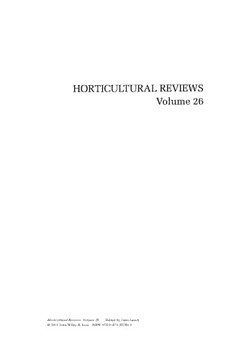
Horticultural Reviews, Volume 26 PDF
Preview Horticultural Reviews, Volume 26
HORTICULTURAL REVIEWS Volume 26 Horticultural Reviews: Volume 26 Edited by Jules Janick © 2001 John Wiley & Sons. ISBN: 978-0-471-38789-3 HorticulturalReviews is sponsoredby: American Societyfor Horticultural Science Editorial Board, VoluDle 26 Natalia Dudareva Linus U. Opara Dariusz Swietlik HORTICULTURAL REVIEWS Volume 26 edited by Jules Janick Purdue University John Wiley 8' Sons, Inc. NEW YORK / CHICHESTER/ WEINHEIM / BRISBANE / SINGAPORE / TORONTO e Thisbookis printedonacid-freepaper. Copyright©2001byJohnWiley& Sons,Inc. Allrightsreserved. PublishedsimultaneouslyinCanada. Nopartofthispublicationmaybereproduced,storedinaretrievalsystemor transmittedinanyform orbyanymeans,electronic,mechanical,photocopying, recording,scanningorotherwise,exceptaspermittedunderSections107or108ofthe 1976UnitedStatesCopyrightAct,withouteitherthepriorwrittenpermissionofthe Publisher,orauthorizationthroughpaymentoftheappropriateper-copyfeetothe CopyrightClearanceCenter,222RosewoodDrive,Danvers,MA01923,(978) 750-8400, fax (978) 750-4744.RequeststothePublisherforpermissionshouldbeaddressedtothe PermissionsDepartment,JohnWiley& Sons,Inc.,605ThirdAvenue,NewYork,NY 10158-0012,(212)850-6011,fax (212)850-6008,E-Mail:[email protected]. Thispublicationisdesignedto provideaccurateandauthoritativeinformationinregard tothesubjectmattercovered.Itissoldwiththe understandingthatthepublisherisnot engagedinrenderingprofessionalservices.Ifprofessionaladviceorotherexpert assistanceisrequired,theservicesofacompetentprofessionalpersonshouldbesought. LibraryofCongressCatalog CardNumber: 79-642829 ISBN0-471-38789-4 ISSN0163-7851 109 8 76 5 4 3 2 1 Contents Contributors ix Dedication: A. A. De Hertogh xi Paul V. Nelson 1. Protea: A Floricultural Crop from the Cape Floristic Kingdom 1 f. H. Coetzee and G. M. Littlejohn I. Introduction 2 II. History 5 III. Reproductive Biology 10 IV. Crop Improvement 13 V. Physiology 21 VI. Production 29 VII. Conclusion 38 Literature Cited 40 2. The Molecular Biology ofPlant Hormone Reception 49 Carole L. Bassett I. Introduction 50 II. Current Status ofSignalReceptorResearch 53 III. Plant Hormone Receptors 60 v vi CONTENTS IV. FutureProspects 75 Literature Cited 78 3. Molecular Biology ofCassava 85 Johanna Puonti-Kaerlas I. Introduction 86 II. Botanyand Distribution 87 III. Productionand Use 90 IV. Constraints to Cassava Use and Cultivation 94 V. Traditional Breedingand Biotechnology in CassavaImprovement 94 VI. MolecularGenetics 95 VII. Tissue Culture and Regeneration 99 VIII. Genetic Transformation 112 IX. Applications and Potential MolecularBiology 119 X. FutureProspects 132 LiteratureCited 134 4. Postharvest Physiology and Quality ofCoated Fruits and Vegetables 161 Cassandra AmaranteandNigelH. Banks I. Introduction 162 II. PermeabilityofCoating Films andPermeance ofCoated Commodities 165 III. Physico-Chemical Characteristics, and BarrierProperties to Water Vapor and Gases, ofEdible Coatings 170 IV. Factors AffectingWaterLoss, Gas Exchange, and Modification ofInternal Atmosphere ofCoated Commodities 181 V. Postharvest Physiologyand Quality ofCoated Commodities 197 VI. Summaryand Conclusions 224 LiteratureCited 227 CONTENTS vii 5. Greenhouse Tomato Fruit Quality 239 M. Dorais, A. P. Papadopoulos, andA. Gosselin I. Introduction 240 II. Quality Attributes 243 III. Genetic Characteristics AffectingTomato Fruit Quality 262 IV. Environmental Factors Affecting Tomato FruitQuality 264 V. Cultural Practices Affecting FruitQuality 271 VI. Postharvest 291 VII. Conclusion 294 Literature Cited 296 Subject Index 321 Cumulative Index 323 Cumulative Contributor Index 345 Contributors CassandroAmarante, Centre ofAgricultural, Horticulturaland Veterinary Sciences, SantaCatarinaStateUniversity,CaixaPostal 281, CEP88520-000, Lages, SC, Brazil, [email protected] NigelH. Banks,CentreforPostharvestandRefrigerationResearch, Institute for Food, Nutritionand HumanHealth, MasseyUniversity,Palmerston North, NewZealand, [email protected] CaroleL. Bassett, USDA-ARS,AppalachianFruitResearchStation, 45 Wilt shireRoad, Kearneysville, WV 25430, [email protected] J. H. Coetzee,AgriculturalResearchCouncil: Fynbos,PrivateBagXl,Elsen burg, 7607 SouthAfrica, [email protected] M. Dorais,Agriculture and Agri-FoodCanada, Greenhouse & Processing Crops ResearchCentre, Harrow, ON, NOR lGO, Canada, [email protected] A. Gosselin,Horticulture ResearchCentre, LavalUniversity, Sainte-Foy,QC, G1K 7P4,Canada G. M. Littlejohn,Agricultural ResearchCouncil: Fynbos, PrivateBagXl, Elsenburg, 7607 SouthAfrica, [email protected] PaulV. Nelson, DepartmentofHorticulturalScience, NorthCarolinaState University, Raleigh, NC 27698-7609, [email protected] A.P.Papadopoulos, Agriculture andAgri-FoodCanada,Greenhouse& ProcessingCropsResearchCentre, Harrow, ON,NOR lGO, Canada [email protected] JohannaPuonti-Kaerlas,Institute for PlantSciences,ETH-Zentrum/LFWE 17,CH-809Z Zurich, Switzerland, [email protected] ix AugustA. DeHertogh Dedication: August A. De Hertogh Who can deny thatthe profusion ofspring floweringbulbs inthe land scape and interior environments are truly wondrous? While flowering bulbs are miraclesofnature,we haveAugust (Gus) DeHertoghto thank for helpingto successfullybringthese gifts into our lives. Dr.DeHertogh'scontributionstohorticulturearetrulyoutstanding.He is aworldauthority on floweringbulb plants (geophytes) andhis career embraces the science, technology, industry practice, and education in that world. His integration of science, technology, economic applica tion, and public education serves as amodel for all horticulturists. When Gus began his workon flower bulbs atMichigan State Univer sity in 1965, it was not possible to effectively control the flowering of tulips or other bulbs following overseas shipment from The Nether lands, the world's largest producer. He not only developed procedures to successfullyshipbulbs across theAtlanticOceanbutalso developed productionprotocols for handlingbulbs uponarrival, properlycooling bulbs, and then forcing bulbs in the greenhouse from January through Mayforpotandcutflowermarkets. Hedevelopedproductionschedules for every major flowering bulb produced in the United States, The Netherlands, SouthAfrica,Israel,Australia, andNewZealand. Inshort, he managed, through science and technology, to take an age-old indus try and advance it into a new age with many economic opportunities. He has been instrumental in expanding the world market of flower bulbs. Dr. De Hertogh pioneered university-industry partnerships when he began collaborative efforts with the Netherlands Flower Bulb Institute andtheHollandBulbExportersAssociation. From1965to 1970,Dr. De Hertogh and his team conductedbasic physiology studies offlowering bulbs.Thislaidthefoundationfortheproductionofthefirst offive edi tionsoftheHollandBulbForcersGuide,whichisconsideredthe "bible" for bulb producers and forcers. One ofthe striking attributes ofDr. De Hertogh's career is his inex haustible zeal to educate people from all walks ofthe geophyte world. Thebreadth ofmedia for his publications speaks to this desire to com municate equally to scientist, producer, and end user. These publica tions encompass 52 journal articles, 55 symposia/research reports, 58 xi
